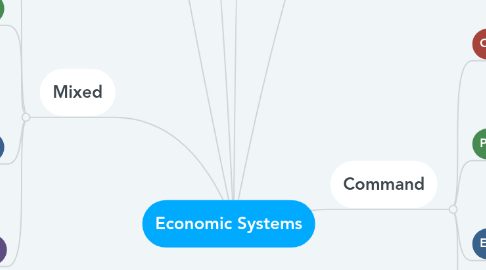
1. The United States operates as a mixed market economy. While typical government influence is low in this type of economy, the US Market Economy works because of the government Protects: • Innovation by establishing a copyright clause. • Free Enterprise by prohibiting states from taxing each others' goods and services. • Private property by protecting people from unreasonable searches and seizures and prohibits the state from taking away property without due process of law. • All Rights by limiting the government's power to interfere in anything that is not expressly outlined in the Constitution.
2. Market
2.1. Cons
2.1.1. Elderly, children and people with mental or physical disabilities may be at a competitive disadvantage.
2.1.2. Economy produces unbalanced results, meaning that some become very rich while others are very poor, homeless, etc.
2.2. Pros
2.2.1. Goods and services are produced efficiently.
2.2.2. Rewards Innovation.
2.2.3. The government could protect the free market so much that it doesn’t regulate enough, in situations such as government bailouts.
2.2.4. Consumers are willing to pay higher prices for the things they want the most.
2.3. Examples
2.3.1. Employees demand highest wages employers are willing to pay and Businesses sell goods according to the highest prices consumers are willing to pay.
2.4. Definition
2.4.1. In a market economy there is little government influence. This is an economic system whereby decisions on the price of products and services are determined by Supply & Demand.
3. Mixed
3.1. Cons
3.2. Pros
3.2.1. It allows the federal government to protect the market and its people.
3.2.2. If there is not enough competition and too much freedom in the marketplace, it can provide little support for those who are less competitive.
3.2.3. Distributes services and goods to where they are needed the most.
3.2.4. Customers get the best value for their money since this economy rewards the most efficient producers with the highest profits.
3.3. Examples
3.3.1. In a Global Command Economy, there is no single government who controls it. World organizations have implemented some regulations and agreements. But no world government has the power to create a global command economy.
3.4. Definition
3.4.1. A mixed economy benefits from advantages of the other three economic types, including traditional, command, and market while not being affected by the disadvantages of this economic market type. A Mixed Economy Protects private property, is driven by the motivation of the self-interest of individuals, and allows the free market and the laws of supply and demand to determine pricing strategies.
4. Tradition determines resource distribution, so there are fewer disagreements between members.
5. Command
5.1. Cons
5.1.1. Command economies usually produce too much of one thing and not enough of another since the plans are created ahead of time and they sometimes do not accurately anticipate consumer demand for products and services.
5.2. Pros
5.2.1. Command economies can quickly mobilize economic resources since they are planned out on a large scale and thereby meet social goals, create industrial powers, and execute expansive projects.
5.2.2. Command economies can wholly transform societies to conform to the government's vision.
5.3. Examples
5.3.1. The government creates a central plan and then allocates all resources according to that plan. The goal of this plan is to Its goal is to supply enough food, housing, and other basics to meet the needs of everyone in the country.
5.4. Definition
5.4.1. In a command economy, governments own the means of production and the land products are produced on and also make all economic decisions. Supply and Demand Laws do not apply in this type of economy and traditional customers are ignored.
6. Traditional
6.1. Cons
6.1.1. Traditional economies are vulnerable to economies and societies often consume natural resources, such as when they wage wars.
6.2. Pros
6.2.1. Smaller groups so little carbon footprint on the environment.
6.2.2. They only product what they need to survive.
6.2.2.1. Traditional economies produce only what they need, so leftovers or a surplus is not usually seen. This strategy makes money and trade an unnecessary objective.
6.3. Examples
6.4. Definition
6.4.1. A traditional economy is a system that barters instead of using money and relies on history, beliefs, and customs. Decisions are guided by distribution and production. Traditional economies are dependant upon hunting fishing, and agriculture
